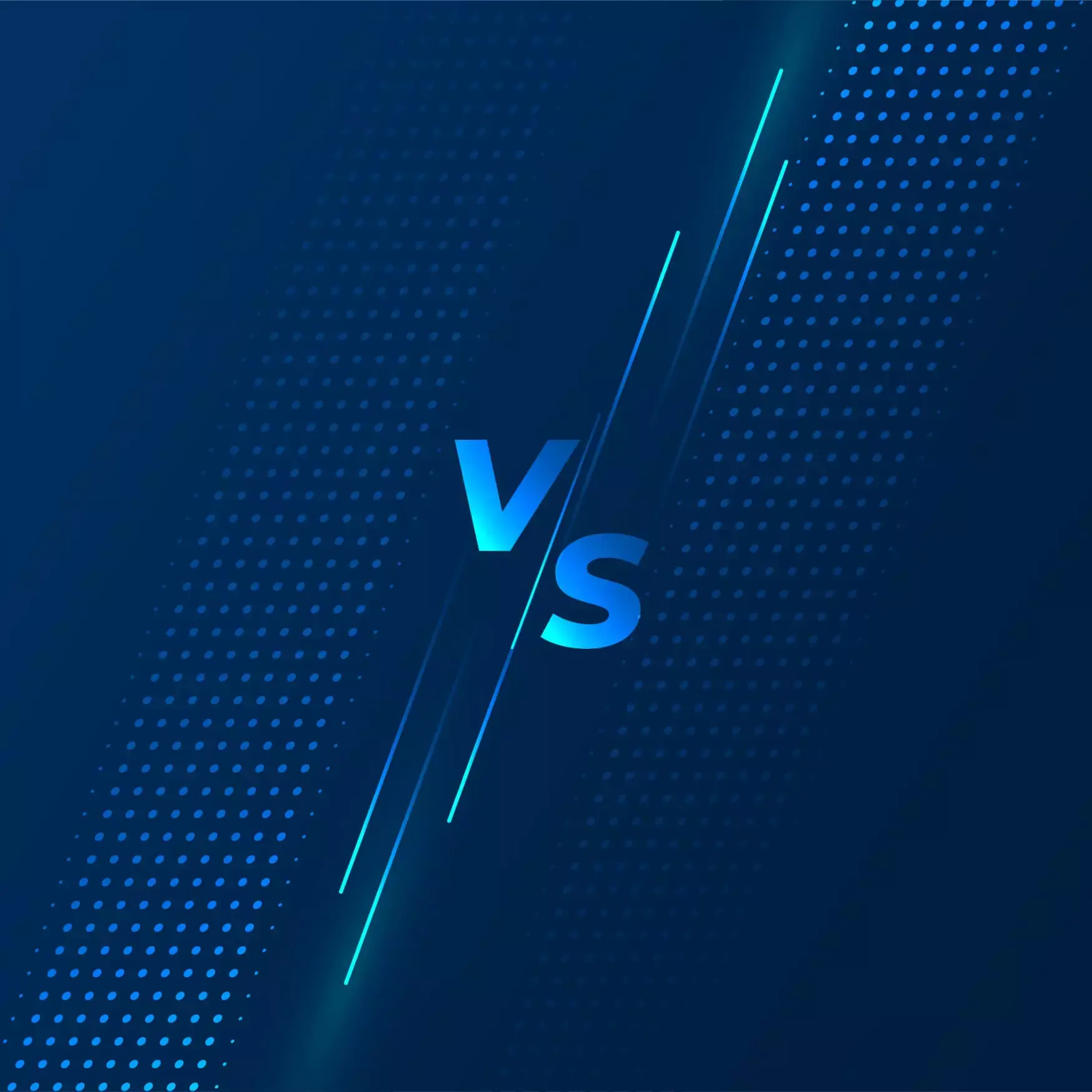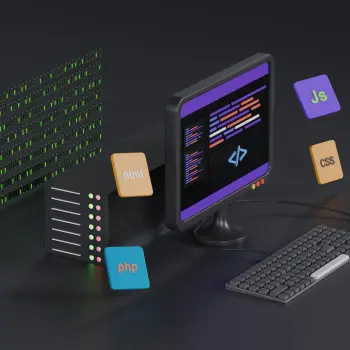Now, we stand on the brink of a new era in digital evolution, so the dynamics of web application architecture are undergoing a transformative shift.
In this full guide, we embark on a journey through the cutting-edge landscape of web application architecture, unraveling the latest trends and innovations that define 2025. We will consider the types and layers of architecture of modern web applications. You will find helpful recommendations on optimizing architecture, creating it right, and more.
Join us as we explore the intricacies of the ever-evolving web application architecture, unveiling the key elements that pave the way for enhanced performance, scalability, and security in the digital realm. Let’s dive into the subject!
What is web application architecture?
According to Statista, the worldwide web app development market volume will rise to $234,70 billion by 2028. Thus, web application development seems a profitable field for starting a business. But to create a thriving solution, it is essential to start with the understanding of its backbone – web application architecture. So, what is it?
A web architecture diagram is the blueprint that dictates the functionality and structure of web-based apps. This architecture serves as the foundation for developing efficient, scalable, and robust apps that cater to the ever-evolving demands of users in the digital landscape.
By the way, you can read our comprehensive article on the comparison of a website vs web application.
Essential components of web application architecture
Typically, the architecture of modern web applications encompasses three fundamental elements:
Frontend (client-side)
The web browser, the client-side or frontend, is a component that plays a pivotal role in user interaction. It receives inputs, manages presentation logic, and controls user engagement with the application. Additionally, it validates user inputs when necessary.
Backend (server-side)
Being the backend or server-side component, the web server is responsible for executing the business logic and processing user requests. It efficiently routes requests to the appropriate components, overseeing the seamless operation of the entire application. It has the capability to handle requests from a diverse range of clients.
Database
It is an integral part that furnishes the necessary data for the application. Tasked with data-related functions, the database server plays a key role in managing stored procedures and, in a multi-tiered architecture, may contribute to handling business logic.
The concept of 3 tier web application architecture
Within the conventional 2-tier web architecture diagram, two integral components come into play: the client-side system, responsible for the user interface, and the backend system, typically represented by a database server. In this setup, the business logic finds its place either within the user interface (UI) or the database server.
However, a drawback of this architecture surfaces as performance dwindles with an upsurge in user numbers. Additionally, the direct interaction between the user device and the database creates web application security architecture issues.
So, the architecture of modern web applications adheres to the foundational 3-tier concept. This architectural paradigm systematically divides applications into three distinct tiers:
- The presentation tier (client layer) that is responsible for user interface interactions;
- The application tier (business layer), managing core application functionality;
- The data tier handles the storage and retrieval of information.
Creating a visual representation of 3 tier architecture web application, often in the form of diagrams or charts, helps stakeholders, including developers, architects, and project managers, understand the data flow. The architecture diagram for web application also assists in understanding interactions between components and potential points of optimization or concern within the system.
Below, you can see a web architecture diagram:
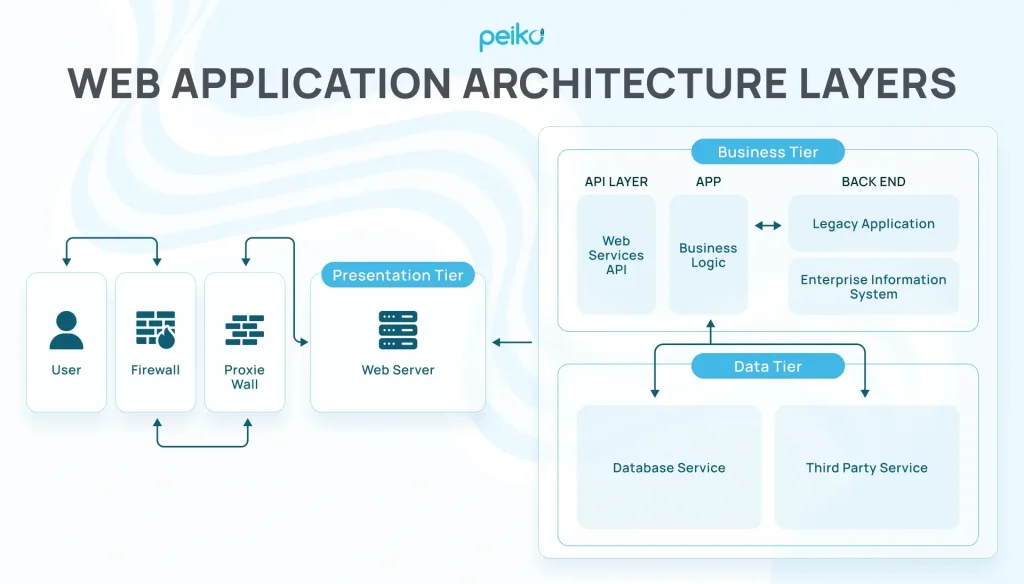
In the 3-tier architecture diagram for web application, each layer operates on dedicated infrastructure, enabling parallel development by distinct teams. This configuration facilitates the independent updating and scaling of each tier as required without causing disruptions to the functionality of other tiers.
Presentation tier: client layer
Within the schematic of a website application architecture diagram, the client-side component serves as the gateway for users to engage with both the server and backend services through their browsers.
Embedded within the browser, the code manages incoming requests and adeptly delivers the necessary information to users. This realm is where UI/UX design, notifications, configurational settings, dashboards, layout, and interactive elements seamlessly converge.
Let’s delve into some commonly used frontend technologies for client-side architecture:
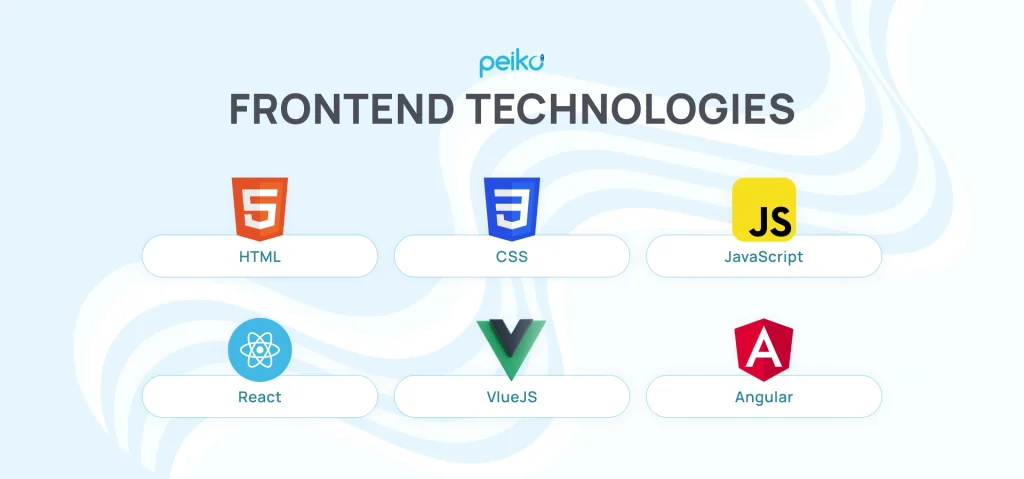
HTML (Hypertext Markup Language)
This technology, conceived by Tim Berners-Lee in 1993, stands as a foundational markup language. Developers employ HTML to structure web page contents through a series of elements. Its evolution over the years has positioned HTML as a global standard for web development.
CSS (Cascading Style Sheets)
It is a popular style sheet language that enables the separation of site content and layout. With CSS, developers can define styles for elements, facilitating reusability across multiple instances.
JavaScript (JS)
JavaScript, designed by Brendan Eich in 1995, reigns as the most widely used client-side programming language. Its simple syntax and interoperability make it a go-to choice for enhancing user interfaces and experiences.
React
This open-source JavaScript library, introduced by Jordan Walke in 2013, has gained prominence for creating dynamic web applications with minimal effort. Its ease of learning, reusability, and utilization of a virtual DOM contribute to enhanced efficiency and optimized memory usage.
VueJS
It is a JavaScript framework crafted by Evan You in 2014 that empowers developers to build UI interfaces for web, desktop, and mobile applications. With a lightweight toolkit, two-way data binding, and good community support, VueJS is a versatile choice.
Angular
This open-source web app framework from Google, introduced in 2016, has emerged as a comprehensive solution for frontend development. Leveraging NGModules, Angular facilitates the rapid development of applications with features like components, modules, templates, and more.
Application tier: web server
A web server is responsible for hosting website architecture or web applications, utilizing protocols like HyperText Transfer Protocol (HTTP) to handle user requests through a browser. It handles these requests, implements the required business logic, and finally presents the desired content to the end user.
A web server can take the form of either a hardware device or a software program.
- Hardware web server: This refers to a computer device linked to the internet, furnished with web server software and crucial web app components like images, HTML documents, JS files, and CSS style sheets.
- Software web server: In contrast, a software web server is a program adept at interpreting URLs and HTTP protocols. Users can access it through domain names to retrieve the content they seek.
Distinguishing features include static web servers, which deliver content to the browser as is, and dynamic web servers, which update data before presenting it to the user.
Here’s a look at some commonly employed server-side technologies:
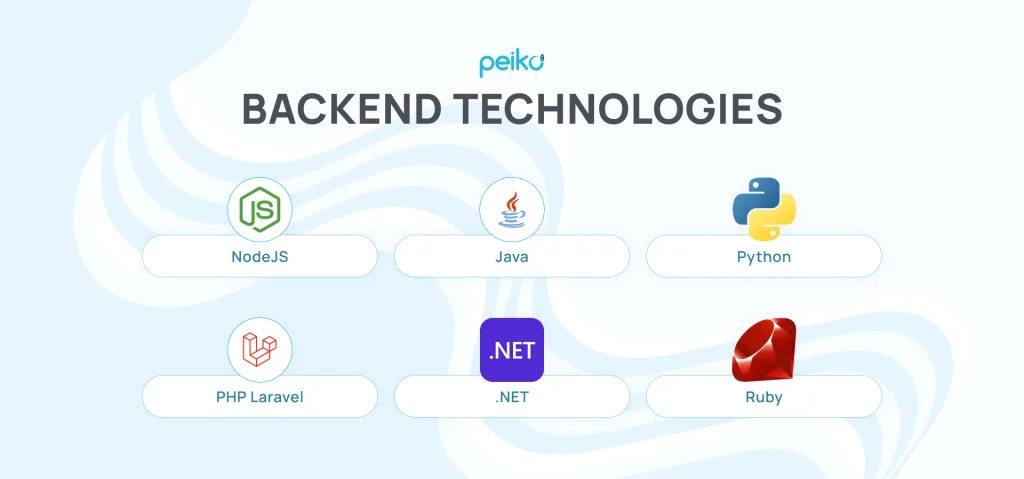
NodeJS
This cross-platform, open-source runtime environment crafted by Ryan Dahl in 2009 utilizes the Google Chrome V8 Engine. It enables developers to build network and server-side applications using JavaScript.
With a rich library of modules, NodeJS facilitates swift application creation. Its asynchronous, event-driven, and highly scalable nature on a single thread makes it ideal for data-intensive, data-streaming, I/O-bound, and JSON-API-based applications.
Java
Introduced by James Gosling in 1995, Java stands as one of the most well-known and effective programming languages. Its object-oriented and class-based nature allows developers to write code once and run it on any platform by applying a Java Virtual Machine (JVM).
Java boasts easy learning, coding, compilation, and debugging, making it cost-effective for building and running programs.
Python
Guido Van Rossum’s creation of Python in 1991 has risen as a fast-growing and versatile programming language. Its flexibility, simplicity, and extensive feature set make it an excellent alternative to Java for web application architecture.
Python’s dynamic typing, coupled with a vast library, supports projects ranging from small to large, spanning various domains like mobile apps, video games, and AI programming.
PHP Laravel
This is a PHP framework that streamlines the development of custom web applications. As an MVC-based framework, it offers an elegant syntax and expressive capabilities. Developers benefit from built-in functions, streamlined code writing, and enhanced performance.
Features like automated testing, object-relational mapping support, and cross-site request forgery tokens contribute to Laravel’s appeal.
.NET
Introduced by Microsoft in 2001, .NET serves as a robust software development framework for desktop and web applications. .NET comes in various flavors, including .NET Framework, .NET Core, and Xamarin, catering to different platforms.
Utilizing an Object-Oriented Programming (OOP) model and featuring a modular structure, .NET enables developers to build and manage software products efficiently. Its advantages include a caching system, automatic monitoring in ASP.NET, and platform-agnostic deployment.
Ruby
Developed by Yukihiro Matsumoto in 1995, Ruby offers time efficiency and rapid application development when combined with the Rails framework. With built-in security features to mitigate risks, Ruby is a popular choice for projects that prioritize quick deployment.
Despite speed concerns, particularly for large-scale applications, Ruby finds favor in small to medium-sized organizations. However, its popularity may not match that of Java or Python.
Data tier: database
At the core of a web app lies a pivotal component known as a database. It is responsible for the storage and management of information essential to the application’s functionality. Through tailored functions, a database facilitates the seamless search, filtering, and sorting of information, aligning with user requests to present the requisite data to end-users. Additionally, databases play a crucial role in upholding data integrity by implementing role-based access.
When faced with the decision of selecting a database for your web application architecture, careful consideration of four critical aspects – size, speed, scalability, and structure – is imperative. In scenarios where structured data holds prominence, SQL-based databases emerge as a favorable choice. This preference is particularly evident in apps such as financial platforms, where data integrity stands as a paramount requirement.
Modern web application architecture layers
A modern web application architecture diagram is typically designed with additional layers that go beyond the presentation, application, and data layers to enhance performance, scalability, and security. What are these advanced layers?
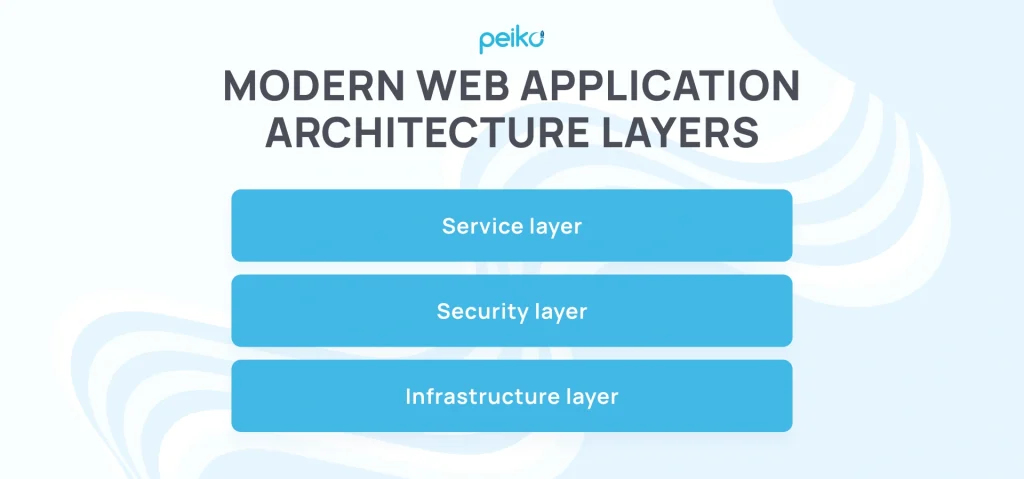
Service layer
The service layer is essential for facilitating smooth interactions between different components of an application, especially within microservice architectures. It functions as a bridge between the presentation and application layers, coordinating data flow and managing APIs to ensure seamless communication.
This layer supports modular design by allowing developers to build and deploy independent services that interact cohesively.
Security layer
The security layer is dedicated to implementing measures that prevent unauthorized access and ensure data protection in compliance with privacy standards. This includes encryption of data both during transmission and while stored, using authentication methods like OAuth and JWT to verify user identities, and applying role-based access control for appropriate authorization.
Security tools such as Web Application Firewalls (WAFs) help guard against attacks like SQL injection, cross-site scripting (XSS), and DDoS.
Infrastructure layer
This layer of web app architecture diagram provides the environment for deployment, scaling, and overall management. It encompasses physical and cloud-based resources like servers, storage, and networking.
Container management systems, such as Kubernetes or Docker Swarm, help deploy, monitor, and scale applications with ease. Serverless computing platforms like AWS Lambda and Azure Functions take this further by managing the underlying infrastructure, allowing developers to focus on writing and deploying code without worrying about server maintenance.
The Peiko team is ready to help

Types of web application architecture
The structure in which a web application is designed influences its performance, scalability, and overall user experience significantly. Here are the general types of web app architecture:
Monolithic architecture
The conventional monolithic architecture embodies a consolidated model in which every element of a web application, encompassing the user interface, business logic, and database, coexists within a singular codebase.
Microservices architecture
This type of architecture, in contrast, is a paradigm that decomposes an application into small, independently deployable services. Each service focuses on a specific business capability, enabling teams to develop, deploy, and scale components independently. This approach enhances flexibility and promotes easier maintenance, making it a popular choice for modern, dynamic applications.
Let’s consider the monolithic vs microservice architecture diagram for web application.
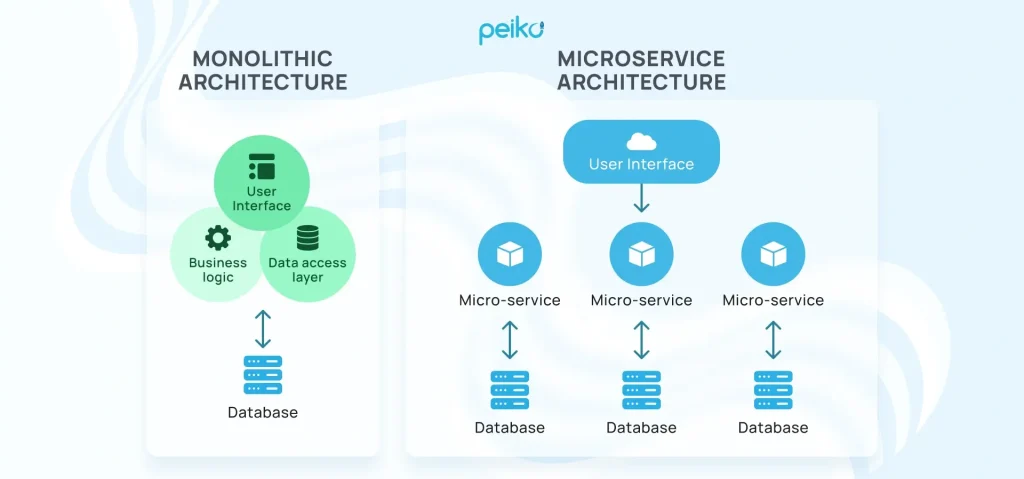
Serverless architecture
This architecture, despite its name, involves servers but abstracts the infrastructure management away from the developer. In this model, developers focus on writing code in the form of functions that execute in response to specific events. Serverless architectures offer exceptional scalability and cost-effectiveness. Below you can see a serverless web application diagram example.
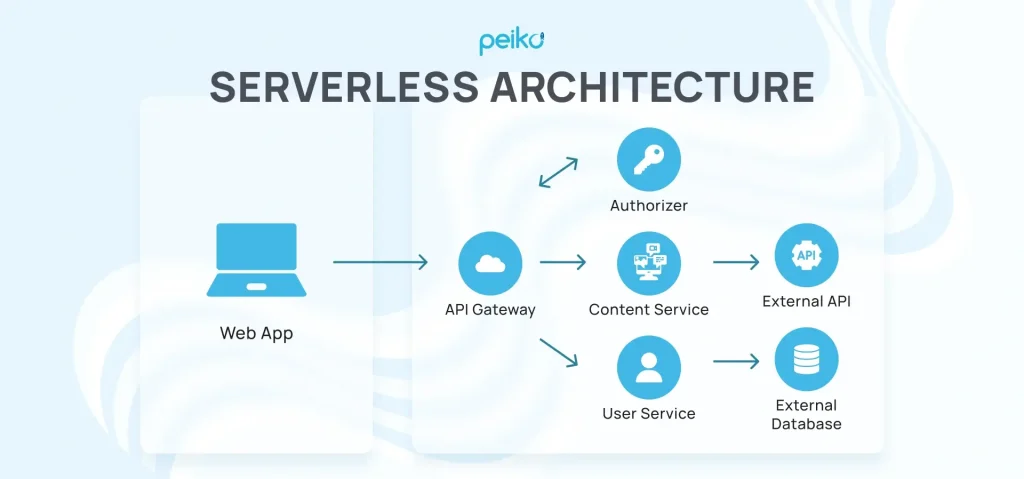
Single-page application (SPA) architecture
In the realm of single-page application (SPA) architecture, this type ensures a seamless user experience by loading a single HTML page and dynamically updating content as users interact with the application. SPAs harness client-side rendering, diminishing the necessity for page reloads.
Multi-page application (MPA) architecture
This conventional design strategy is specifically crafted for applications featuring multiple workflows and varied functions. A multi-page app (MPA) is structured as a collection of dynamic web pages, each dedicated to performing a distinct function and reloading when prompted by a user’s new request.
What sets MPA apart is its ability to accomplish what a single-page application (SPA) might find challenging – facilitating diverse workflows with rich content and features without compromising user experience. This versatility allows for the seamless development of intricate functionalities within an MPA framework, providing users with an engaging and well-balanced web experience.
Here is a sample architecture diagram for web application that compares MPA and SPA architectures.
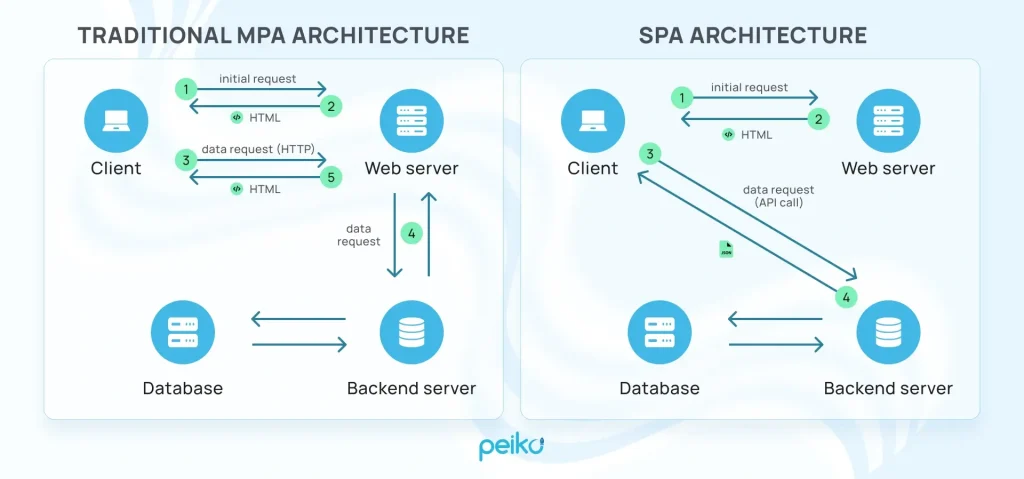
Advanced and scalable web application architecture
In the ever-evolving landscape of software development, adapting to market changes and evolving customer preferences is imperative. Designing an advanced and scalable enterprise web application architecture diagram demands vigilance to the latest trends. Below are key trends shaping web app architecture and their mainstream applications:
Caching system
In traditional architectures, constant database interactions for user requests posed challenges. The advent of caching mitigates this issue by creating a local data storage area, enabling swift data access for application servers. Options include Application Server Cache, Distributed Cache, Global Cache, and Content Delivery Network (CDN).
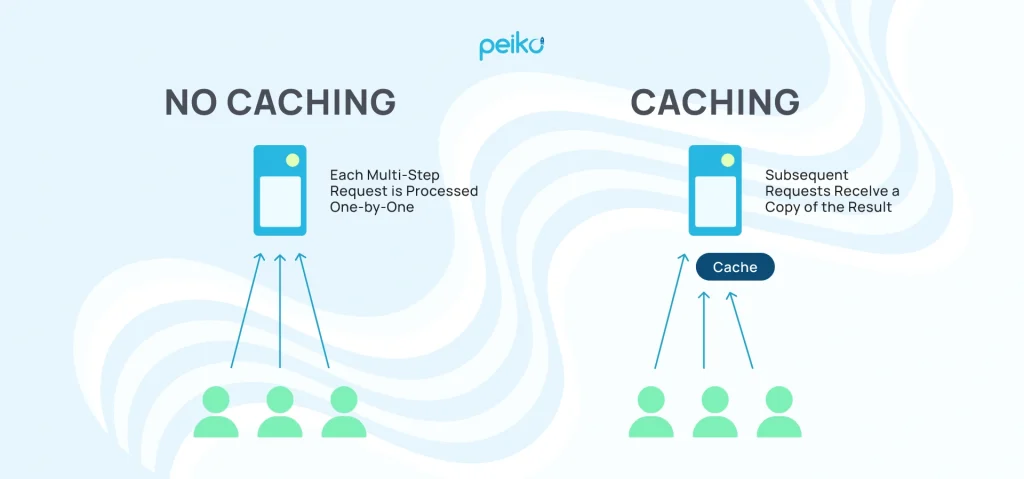
Cloud storage (Amazon S3)
Modern web application architecture necessitates cloud storage. Amazon S3 by AWS is a popular choice, providing flexibility, cost-effectiveness, and durability. Furthermore, the comprehensive security features embedded in Amazon S3 meet the stringent demands of contemporary digital ecosystems.
CDN (CloudFront)
Content delivery networks (CDNs) enhance web performance by sharing content through a network of servers. Amazon CloudFront, a distributed cache system, leads in delivering speed, lower latency, and improved user experience. It integrates seamlessly with AWS web application architecture services, ensuring scalability and advanced web security.
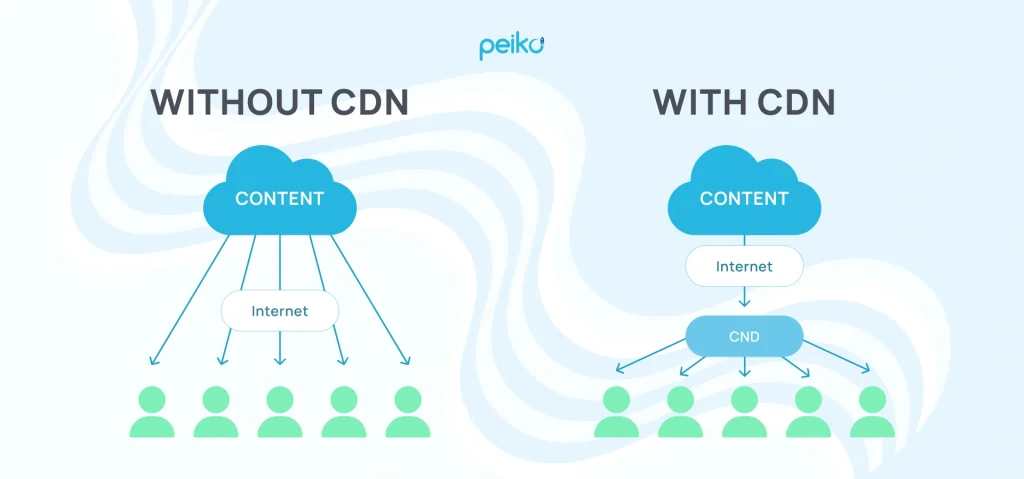
Load balancer
This software distributes site traffic across servers based on availability, enhancing scalability and availability. Load balancing can occur at the TCP/IP level or the app level, optimizing server usage and preventing a single point of failure.
Multiple servers
Traditional architectures may falter with increased user volume. A multi-server web app architecture diagram addresses this by connecting multiple OS deployment servers to a single or multiple databases. This stateless architecture, with server replicas, ensures fault tolerance.
Message queues
In the era of microservices, message queues play a crucial role in facilitating communication between independent building blocks. Amazon SQS, a messaging queue by Amazon, enhances scalability, decouples processes, and improves reliability and performance. Other options include IBM MQ, Apache Kafka, Azure Scheduler, RabbitMQ, and others.
By staying at the forefront of industry advancements, we ensure that our web applications meet the evolving needs and expectations of users. You can confidently turn to us for any web and mobile project creation, PWA development for crypto, and more.

Web application architecture best practices & tools
Crafting a web application architecture is a fluid and intricate journey that requires a steadfast commitment to industry best practices, ensuring a foundation of strength, scalability, and security. We have already considered a sample architecture diagram for web application. Now, let’s delve into the essential guidelines that shape a successful development process:
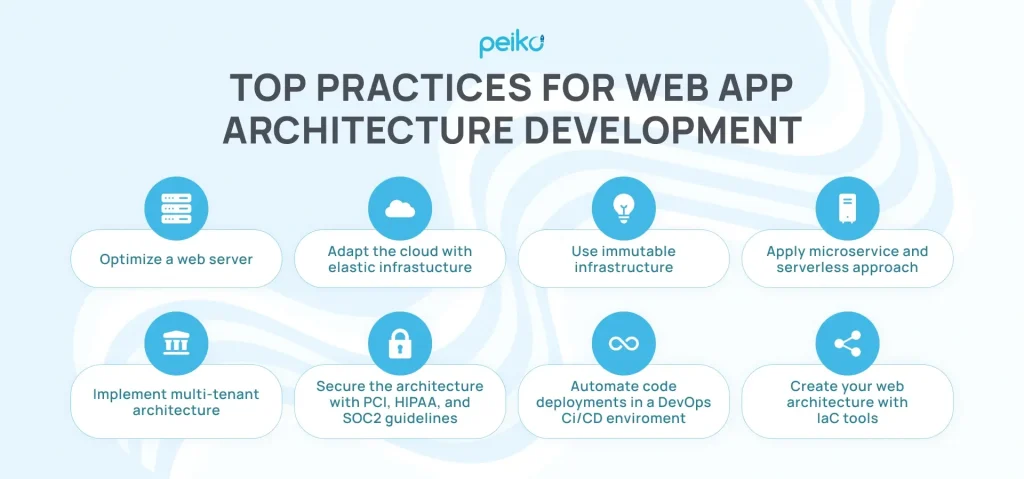
Optimize a web server
Scalability is pivotal in handling the dynamic demands of user traffic. Optimizing a web server involves meticulous configuration adjustments, implementing load balancing mechanisms, and deploying effective caching strategies. This ensures that the web server can gracefully handle varying workloads and deliver optimal performance during periods of heightened user activity.
Adapt the cloud with elastic infrastructure
Embracing cloud services with elastic infrastructure unlocks the potential for dynamic resource scaling based on demand. Cloud platforms provide unparalleled flexibility, cost-effectiveness, and the capability to adapt to fluctuating workloads seamlessly. This approach ensures that your web application can effortlessly scale its resources to meet evolving user requirements.
Use immutable infrastructure
The concept of immutable infrastructure treats infrastructure components as unchangeable entities, reducing configuration drift and promoting consistency across different environments. Adopting an immutable infrastructure approach enhances deployment efficiency, minimizes errors, and fosters a more reliable system.
Apply microservice and serverless approach
Breaking down applications into microservices or embracing serverless architectures introduces agility, scalability, and simplified maintenance. This modular approach facilitates independent development and deployment of services, providing flexibility and fault isolation that are crucial in today’s rapidly changing technological landscape.
Implement multi-tenant architecture
This web app architecture diagram accommodates multiple users or businesses sharing the same application infrastructure. Balancing resource efficiency with data isolation and security measures, this approach is particularly advantageous for software as a service (SaaS) applications, promoting efficient resource utilization and streamlined maintenance.
Secure the architecture with PCI, HIPAA, and SOC2 guidelines
Prioritizing security is a non-negotiable aspect of modern system architecture diagram for web application. These are some of the most popular security protocols:
- PCI DSS (for payment card industry compliance): The Payment Card Industry Data Security Standard establishes a framework of policies and procedures tailored for financial enterprises entrusted with customers’ sensitive financial data. Compliance with this security protocol mandates organizations to deploy and uphold a reliable web application firewall architecture to safeguard financial information.
- HIPAA (for healthcare): Enforcing compliance with the Health Insurance Portability and Accountability Act (HIPAA) is a crucial mandate for healthcare organizations. This legislation plays a pivotal role in mitigating healthcare fraud while safeguarding the confidentiality of private health information, reinforcing trust and security within the healthcare sector.
- SOC 2 (for service organizations): The auditing procedures outlined in SOC 2 (Service Organization Control Type 2) are essential for verifying that cloud service providers effectively and securely manage data. While not mandatory, adhering to SOC 2 guidelines is a prudent choice for enterprises committed to securing customer data.
Adhering to industry-specific guidelines establishes a robust framework to safeguard sensitive data, ensuring regulatory compliance and user trust.
Automate code deployments in a DevOps CI/CD environment
Embracing a DevOps culture with CI/CD (continuous integration and continuous deployment) automates the code deployment process. This streamlined approach accelerates development cycles, minimizes errors, and ensures a reliable and efficient release pipeline. Developers can confidently deliver updates and improvements to the application with greater speed and efficiency.
Create your web architecture with IaC tools
Infrastructure as code (IaC) tools such as CloudFormation or Terraform empower developers to manage and provision infrastructure through code. This approach enhances repeatability, consistency, and version control for infrastructure configurations, fostering an environment where changes are traceable, reversible, and collaborative.
Our expertise in web application development
Peiko is a trusted firm that specializes in providing custom software development services. We offer professional web, mobile, blockchain development services, and many more.
Our expertise in web application development is prominently showcased through the successful realization of the luma project – a comprehensive web platform that connects brands, agencies, and content creators to drive successful partnerships. It had to support the planning and execution of marketing campaigns. This project is a great web application architecture diagram example.
What was our main goal? The primary task was to develop a strong and intuitive platform that could serve as an advanced marketplace, elevating influencer marketing through authentic storytelling.
The Peiko team managed the entire development cycle, including discovery, user flow design, and full-scale development, with seamless integration of social media and payment systems. We integrated APIs from Instagram, YouTube, and TikTok to provide influencer analytics crucial for brand and agency strategies. To ensure the data’s accuracy, we built an innovative algorithm to detect and exclude fake followers.
This modern and reliable finance solution, as well as other our projects like Balneo Travel, highlights our commitment to excellence in web application development.

Results of our work:
Powerful, user-friendly platform
We built a comprehensive web platform from the ground up, enabling smooth collaboration among brands, agencies, and influencers.
Modern and intuitive design
Our platform features a sleek, user-focused design that simplifies navigation and enhances user interaction, ensuring quick and easy access to important tools and data.
Chat feature
We incorporated a secure chat feature that supports real-time conversations between brands, agencies, and influencers. This functionality promotes better collaboration.

Social media analytics
We connected Instagram, YouTube, and TikTok APIs to provide real-time performance insights, giving brands the data they need on reach, engagement, and demographics.
Fake follower detection algorithm
An innovative algorithm was developed to detect and filter out fake followers, ensuring that only genuine data is provided.

Safe payment escrow system
The platform includes an escrow service that manages payments securely, releasing funds only when set milestones are achieved.
The final product is a reliable and efficient solution for campaign management.
Our expertise in web application development has been instrumental in transforming the luma concept into a fully functional influencer marketing platform. From intricate payment integrations to user-centric design, we’ve crafted a top web application architecture diagram example that not only caters but exceeds the expectations of a manifold and dynamic user base.
Conclusion
A robust, high-performance, scalable, and secure web application architecture stands as an indispensable requirement for any digital product operating on a web platform, for example, a crypto currency exchange. How to start a crypto exchange? We know how to help you with this process.
The design and implementation of web architecture demand the expertise of seasoned software engineering professionals with a track record of crafting tailored solutions within your industry.
Should you seek insights into the customized web application software architecture diagram we can devise for your business, feel free to contact us and tell us about your requirements. Our experienced specialists are committed to ensuring your product receives a meticulously tailored and cutting-edge web application architecture.
No comments yet. Be the first to comment!





